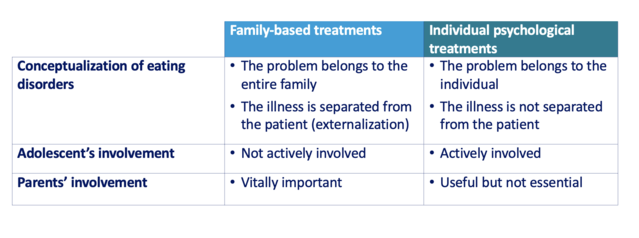Eating Disorders
Clinical Services for Eating Disorders in All Ages
A solution to overcome the transition from adolescent to adult service.
Posted December 4, 2022 Reviewed by Lybi Ma
Key points
- Many people with eating disorders transit from child and adolescent to adult clinical services.
- This transition often creates a gap in regular treatment and interruption of the therapeutic relationship with negative consequences.
- The change in the nature of the treatment often disorients patients and their parents.
- All-age eating disorder clinical services is a potential solution to address these challenges.
Almost 50 percent of eating disorders begin before the age of 18, and the mean age of onset of anorexia nervosa and bulimia nervosa is 17 and 18 years, respectively. Eating disorders often persist for several years, and young people with these disorders require specialized outpatient and sometimes intensive therapies, such as residential or inpatient treatments, until they reach their mid-twenties and beyond.
The above data indicate that many people with eating disorders should address the transition from child and adolescent to adult clinical services. This has been confirmed by studies showing that about 25-35 percent of teenage patients continue their treatment in adult eating disorder clinical services.
Problems associated with the transition from adolescent to adult services
The transition from adolescent to adult eating disorders clinical services is associated with several problems, which are more common in countries with an obligatory change of service at the age of 18.
Gaps in regular treatment
The transition to an adult clinical service often occurs abruptly and may be associated with a gap in regular treatment because of organizational difficulties. Consequently, the young person may not receive therapy for a prolonged time in a crucial moment of their eating disorder management.
Discontinuity in the process of care
The transition can create a discontinuity in the care process by interrupting important and often positive therapeutic relationships with the adolescent team. Patients and families often feel lost and abandoned during this transition.
A different nature of the treatment offered
Traditionally, the nature of the treatment for eating disorders is significantly different in adolescents and adult services, despite adolescents and adults having the same eating disorder psychopathology (e.g., preoccupation with shape and weight, low weight, strict dieting, excessive exercising, binge eating, and purging behaviors).
Adolescent services usually deliver family-based treatments, whereas adult services mainly offer individual psychological therapies. The two approaches significantly differ in the conceptualization of eating disorders and the nature of the involvement of parents and patients (see Table 1).

In family-based treatments, the problem belongs to the entire family, and they separate the illness from the patient (externalization), empowering parents to temporarily take control of their adolescent's eating. In these treatments, the adolescent is not actively involved, while the involvement of the parents is vitally important. In individual psychological treatments, on the contrary, the problem belongs to the individual, and they do not separate the illness from the patient. Therefore, the patient is actively involved in the treatment, while the involvement of parents or significant others is helpful but not essential.
It is understandable why the transition from a family-based treatment to an individual psychological treatment, creating a discontinuity in the nature of care, may often disorient patients and their parents about the procedures and strategies that need to be adopted to overcome their illness, increasing the risk of relapse and negative treatment outcome.
All-age eating disorder clinical services is a potential solution
A potential solution to the above challenge, and implemented in some countries, is organizing clinical services that cover the age range from childhood to young adulthood. These services have the advantage of avoiding disruption of the treatment and discontinuity in the care process. It is also possible to implement evidence-based psychological treatments that can be expanded to the transitional age youth. For this purpose, there are two main possible strategies:
- A reach-up model, extending, for example, the family treatments in the transitional age.
- A reach-down model, adapting, for example, individual psychological treatments to the transitional age.
In my opinion, the second strategy is preferable because patients in the transitional age (e.g., 17-19 years) may find an adapted "adult" form of treatment more acceptable than a family-style form. However, my prediction needs to be tested.
Is enhanced cognitive behavior therapy (CBT-E) the treatment of choice?
CBT-E is one of the major candidates among the individual psychological treatments to be the treatment of choice in all-age eating disorder services. CBT-E was initially developed for adults with eating disorders but has been adapted for adolescent patients with promising results. In CBT-E, parents are actively involved in creating an optimal family environment for facilitating the patient's change and, in agreement with the young person, in supporting them in implementing some treatment procedures. The role of parents as helpers, rather than controllers, as generally is recommended in family treatments, seems particularly suitable for the need of the young with eating disorders who are in the transitional age and are highly concerned about difficulties concerning control and autonomy.
Another important characteristic making CBT-E a potential treatment of choice for all-age eating disorder services is that it has been shown to be effective for all ages and eating disorder diagnoses. Therefore, clinicians who treat eating disorders need to learn a single evidence-based psychological intervention rather than many age and eating disorder-specific therapies.
References
Allison, S., Wade, T., Warin, M., Long, R., Bastiampillai, T., & Looi, J. C. L. (2021). Tertiary eating disorder services: Is it time to integrate specialty care across the life span? Australas Psychiatry, 29(5), 516-518. doi:10.1177/10398562211010802
Dalle Grave , R., & el Khazen, C. (2022). Cognitive behaviour therapy for eating disorders in young people: a parents' guide. London: Routledge.
Herpertz-Dahlmann, B., & Schmidt, U. (2022). We need your ideas-How to deliver developmentally informed treatment and care for emerging adults with eating disorders? A special European Eating Disorder Research issue about age transitions in eating disorders. European Eating Disorders Review. doi:10.1002/erv.2951




